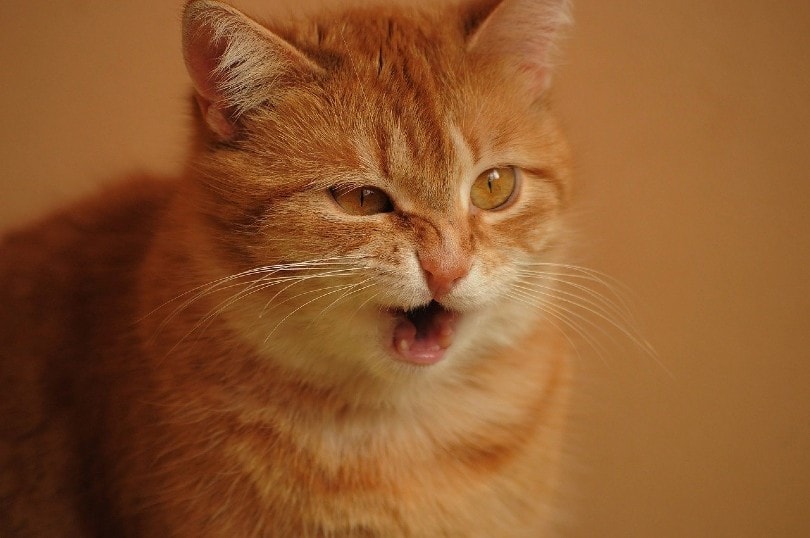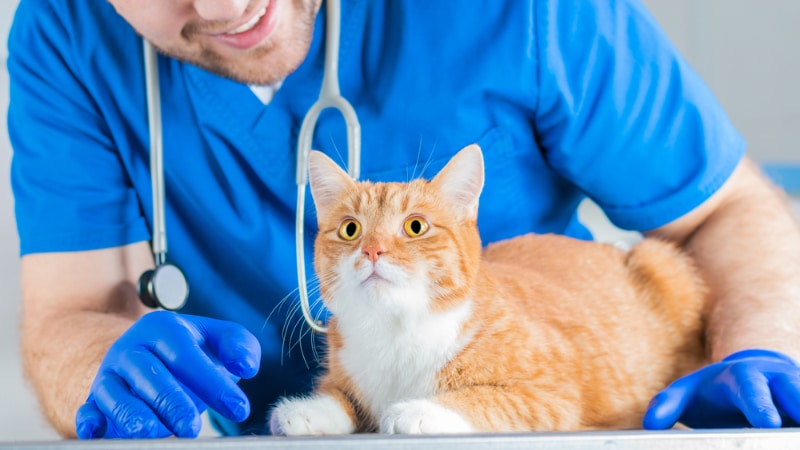When you spend your life surrounded by cats, it’s inevitable that you’ll become familiar with a wide variety of sounds and behaviors, some normal and some not so normal. Reverse sneezing is not something that is commonly seen in cats, and fortunately, it is rarely associated with anything too concerning. However, it’s important to know how to distinguish reverse sneezing from some other respiratory quirks and when to be concerned.
If you see your cat stretching its neck and sniffing air forcefully through its mouth and nose, you will likely see a back and forth sneeze. Let’s see what reverse sneezing is, what causes it, and what else it is.

What is Reverse Sneezing in Cats?
To understand reverse sneezing, it helps to think about what happens when we sneeze. It usually starts with nasal irritation, which causes us to take a deep breath and force the air out with our diaphragm. Also known as paroxysmal respiration, a reverse sneeze is actually exactly what it sounds like. It usually starts with irritation of the nasopharynx (the place where the sinuses enter the throat), which causes a spasm reflex in the diaphragm, which causes air to be forced in through the mouth and nose.
Sneezing and reverse sneezing are both reflexes designed to push irritants out of the nose or pull them away from the nasopharynx. In cats, this is often mistaken for vomiting, as the movement of the diaphragm feels like a lifting of the stomach.
In most cases, cats do not appear overly distressed when they sneeze and recover quickly, which is a factor that helps us distinguish it from other conditions.

What Causes Reverse Sneezing in Cats?
Reverse sneezing occurs more often in dogs, and mainly in brachycephalic breeds, such as Pugs or French Bulldogs. Due to the compression of their internal facial structures, their soft palate is regularly trapped and triggers this reflex. Other causes in dogs include pulling on the leash and compressing the airway, eating or drinking too quickly, and excitement.
In cats, however, the more common triggers for reverse sneezing are:
- Physical irritants (eg, dust, grass, pollen, or hair)
- Mass or tumor (eg.nasopharyngeal polyps)
- Infection
Most physical irritants can be transferred through the act of reverse sneezing. However, a common presentation in cats is grass trapped behind the soft palate. This can often be taken care of by flushing the sinuses but usually requires removal under general anaesthetic.
If the cause is an infection, we can expect to see additional signs, such as a runny nose, watery or sticky eyes, weakness, and dizziness.
If reverse sneezing is due to a growth, such as a tumor or nasopharyngeal polyp, it will often be accompanied by snoring and increased breath sounds, and we expect the signs to gradually worsen.
What Else Could It Be?
- Choking: It is in an emergency. If your cat is choking, they will become very anxious, their eyes may bulge, and their gums may appear blue or purple. If you can see the cause of the choking, it is safe to try to remove the object. Otherwise, lay your cat on its side and, placing a flat hand on either side of the chest, push or tap the rib cage in an attempt to force the object out of the airways. Ideally, do this on the way to the veterinary hospital.
- Hairball Ejection:You’ve probably heard the term “cough up a hairball,” which is a bit misleading. The hairball is in the esophagus, so it is not coughed up, but the action the cat uses to try to expel it looks like coughing or foaming. Cats that shed hairballs often sit close to the ground and stretch their necks while making a panting, hacking sound that is slowly repeated.
It differs from reverse sneezing in that cats usually reverse from a standing or sitting position, and the sneezes are relatively short, sharp, and close together.
- Asthma: A fairly common respiratory disease in cats, mainly showing signs of cat asthma is a chronic cough, wheezing, shortness of breath, open mouth breathing, and rapid breathing. In the early stages, the signs of asthma may resemble reverse sneezing, but as the condition progresses, it becomes clear that it is an issue with the lungs, rather than the upper airway.

Is There a Treatment for Reverse Sneezing in Cats?
In most cases, no treatment is necessary. When the stimulus for the sneezing episode subsides or resolves, the sneezing will also settle. Most episodes last less than a minute, gone as fast as they come.
If reverse sneezing takes longer than this, you can try using a gentle coupage method. Place one palm on one side of the chest. With the other hand, make a cup shape, and gently tap the other side of the breast. This helps force air up the nasopharynx and open the airways.
If the problem persists or if your cat is having regular episodes of reverse sneezing, you should make an appointment with your veterinarian.

Can I Stop Reverse Sneezing?
The best thing you can do to help reduce your cat’s risk of inhaling irritants is to reduce dust and debris in the air, and regular vacuuming is the number one best way to combat this. . Make sure your vacuum cleaner uses a HEPA filter. Other things you can do is to use a low dust cat litter, and, if your cat goes outside, keep them on windy days or when the pollen count is high.
Making sure your cat sees a vet at least once a year for their annual checkup is one of the best things you can do for your cat. This is when small changes and subtle signs can be detected, before your cat lets you know there is a problem. Heart or lung issues, changes or lumps in the abdomen, ear or throat inflammation, and dental pain are all problems that can be picked up in a veterinary exam, that you may not be aware of.

Final Thoughts
Reverse sneezing in cats is a relatively uncommon occurrence and not usually a cause for concern. However, if this becomes a regular occurrence for your cat, or they show any other signs, a visit to the vet is definitely in order. In most cases, the reverse sneeze will stop as quickly as it does, but some cats may appreciate a pat on the chest to help clear up the problem.
If you’re not sure if your cat is repeatedly sneezing, it’s always a good idea to make an appointment for a checkup. It is better to get professional confirmation that everything is fine than to miss the opportunity to deal with a breathing problem in the early stages.
Featured Image Credit: ZlataMarka, Shutterstock


